

Scientists flag Rocky Mountains, Hudson Bay as hotspots for protection. In 2017 conservation scientist Aerin Jacob was invited to join an expert team charged with advising the Canadian government on ways to meet its conservation targets.
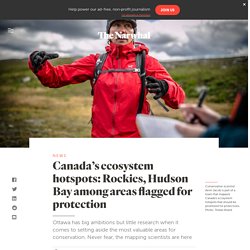
The team was asked to identify areas that provide important ecosystem services — such as landscape-based carbon storage, flood prevention, fresh water and food resources and outdoor recreation — so they could be taken into account when deciding where to put new protected areas. But there was just one problem: that information didn’t exist. “We were astonished to find that Canada has no maps of ecosystem services at national levels,” says Jacob, who works with the Yellowstone to Yukon Initiative in Canmore, Alta. “As scientists who care about environmental decisions, we don’t think the government should be guessing.” So Jacob and several other members of the expert team decided to create those maps themselves.
Ice Caves Photography in Iceland. 11 Images of Nature You Won't Believe Aren't Photoshopped. One thing we've discovered over and over again is that nature is always weirder than what we give it credit for.

That's why, for instance, some of the most staggering naturally occurring landscapes on Earth don't look like they belong on Earth at all. They look like they were created in a lab, or beamed down to our world from a distant fold in the universe. Tell us you wouldn't think you'd been kidnapped by aliens if one day you woke up to see ... Identifying key ecosystem services providing information for national-scale conservation planning. How to meet the ambitious target of conserving 30 per cent of Earth by 2030. Canada has an extensive system of protected areas that, when added together, would cover an area slightly larger than Ontario.

That’s larger than France and Spain combined, and more than three times the size of Germany. But Canada also has a new conservation goal called 30 by 30, which aims to conserve at least 30 per cent of the nation’s lands and waters by 2030. Meeting this ambitious goal would mean roughly doubling Canada’s protected area.
A good life for all within planetary boundaries. A good life for all within planetary boundaries. 1.Raworth, K.
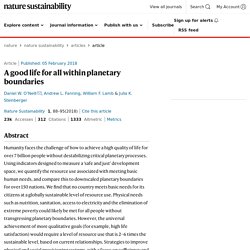
A Safe and Just Space for Humanity: Can We Live Within the Doughnut? (Oxfam, Oxford, UK, 2012). Google Scholar 2.Raworth, K. Doughnut Economics: Seven Ways to Think Like a 21st-Century Economist (Random House, London, 2017).3.Steffen, W. et al. Planetary boundaries: guiding human development on a changing planet. Open Research: The Earth System: Sustaining Planetary Life Support Systems.
Bioremediation. Biomimetics. Velcro tape mimics biological examples of multiple hooked structures such as burs.
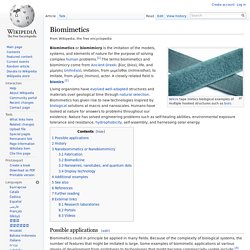
Biomimetics or biomimicry is the imitation of the models, systems, and elements of nature for the purpose of solving complex human problems.[1] The terms biomimetics and biomimicry come from Ancient Greek: βίος (bios), life, and μίμησις (mīmēsis), imitation, from μιμεῖσθαι (mīmeisthai), to imitate, from μῖμος (mimos), actor. A closely related field is bionics.[2] Possible applications[edit] Biomimetics could in principle be applied in many fields. Saprotrophic nutrition. Type of heterotrophic nutrition Mycelial cord made up of a collection of hyphae; an essential part in the process of saprotrophic nutrition, it is used for the intake of organic matter through its cell wall.
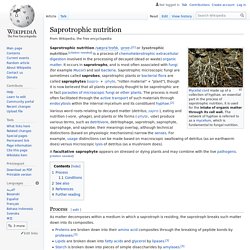
The network of hyphae is referred to as a mycelium, which is fundamental to fungal nutrition.
Why NCS > Natural Climate Solutions Alliance. Maintaining healthy forests, agricultural land, and coastal ecosystems offer a significant opportunity to achieve global climate goals.

Greenhouse gas (GHG) emissions from agriculture, forestry, and other land use (AFOLU) contribute to about a quarter of emissions and must be reduced to limit the global average temperature rise to 2°C. Equally, terrestrial and coastal ecosystems are one of the few available options to take in carbon and deliver GHG emissions to net-zero quickly and cost-effectively. Studies have shown that natural climate solutions (NCS) can provide around 30% of the emissions reductions needed to limit global warming to 2 °C. Reviewery. The sealed bottle garden still thriving after 40 years. David Latimer first planted his bottle garden in 1960 and last watered it in 1972 before tightly sealing it shut 'as an experiment'The hardy spiderworts plant inside has grown to fill the 10-gallon container by surviving entirely on recycled air, nutrients and waterGardeners' Question Time expert says it is 'a great example just how pioneering plants can be' By David Wilkes for the Daily Mail Published: 10:45 BST, 24 January 2013 | Updated: 16:33 BST, 6 March 2016 To look at this flourishing mass of plant life you’d think David Latimer was a green-fingered genius.
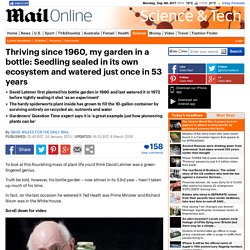
Truth be told, however, his bottle garden – now almost in its 53rd year – hasn’t taken up much of his time. How Wolves Change Rivers. The nine boundaries humanity must respect to keep the planet habitable. All life on Earth, and human civilization, are sustained by vital biogeochemical systems, which are in delicate balance.
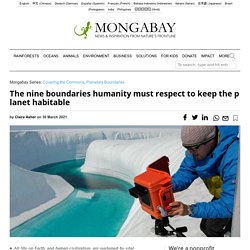
However, our species — due largely to rapid population growth and explosive consumption — is destabilizing these Earth processes, endangering the stability of the “safe operating space for humanity.”Scientists note nine planetary boundaries beyond which we can’t push Earth Systems without putting our societies at risk: climate change, biodiversity loss, ocean acidification, ozone depletion, atmospheric aerosol pollution, freshwater use, biogeochemical flows of nitrogen and phosphorus, land-system change, and release of novel chemicals.Humanity is already existing outside the safe operating space for at least four of the nine boundaries: climate change, biodiversity, land-system change, and biogeochemical flows (nitrogen and phosphorus imbalance). Advanced human societies emerged during an unprecedented period of stability on Earth.
Documentaries to Watch on Earth Day. Eco.logic. Planta. FOOD. Agri.Culture. Animalis. Earth Processes. Genetic Variations. Human History. Basic Needs. Water Precariousness. Natural History. Sky Dome. Carbon Cycling. Crash Landing. Donut's Worth. World Worx. Worldly Info. Nature.